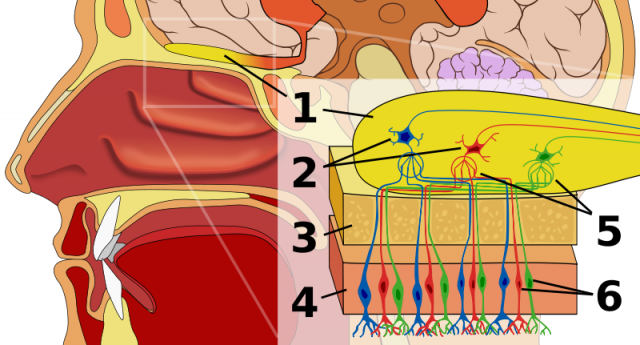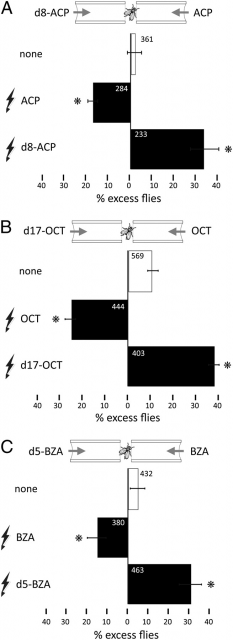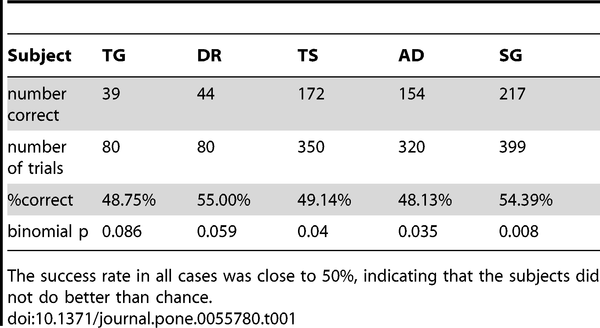We Still Don’t Know How We Smell: The Shape and Vibrational Theories of Olfaction

Olfaction is one of the most important senses. It protects us from eating spoiled food, it helps animals to detect their relatives, it makes the perfume business quite successful and, in general, it connects us to the volatile chemicals surrounding us. These chemicals, usually called “odorants”, can be detected even if they are in a very low concentration. How this detection, and identification, takes place is a question that is still under debate, and recently new experimental data have been released.
The main theory about olfaction states that the electronic shape of the molecule allows them to activate certain receptors of the olfactory system. This is usually referred as the shape theory. In contrast, R.H Wright proposed a second theory in 1937 called the vibrational theory. This second theory was largely abandoned until, in 1996, Luca Turin proposed a concrete mechanism about how it could work 1. In this paper Turin speculated with the possibility of some receptors measuring molecular vibrations together with the electronic shape. This vibrations, produced in the nuclei of the atoms composing the molecule, can allow a quantum process called “electron tunneling”.
The vibrational theory of olfaction was first tested in an experimental way by a psychophysical experiment 2. In this experiment researchers prepared some molecules with the same electronic shape, but different vibrational behavior. One of the molecules used was acetophenone (AP). Hence, in order to change the vibrational component they prepared also deuterated acetophenone (AP-d8). That new molecule is equal to the regular one, but some of the atoms have been replaced by isotopes, with different number of neutrons. That makes a strong difference in the nuclei without affecting the electronic shape of the molecule. Then, they told people to distinguish both components by smelling. Some of the results are summarized in Figure 2.

For the sake of simplicity, let’s focus only on the results involving AP and AP-d8. The experiment was performed under a double-blind protocol where neither the subjects nor the test administrator knew which odorant was in the vial. In (a) the question was to classify the differences between the odors. They made different trials where sometimes both components were the same and some other they were different. The results show that the differences were not bigger when the subjects smell the regular and deuterated acetophenone than when both vials contained the same component. In experiment (b) the purpose was to distinguish both components from different vials, in (c) to distinguish from three samples two of which were equal, and in (d) the results for different concentration of both components are displayed. The results are clear, humans cannot distinguish AP from AP-d8 by smelling, even if their vibrational energies are very different.
Does this mean that this theory should be rejected? Not yet. Biological and psychophysical tests are complicated and they should be performed in different ways. Furthermore, recently new experiments have been performed 3, now involving fruit flies, and the results point into a complete different direction. In this experiment flies where trained, by electrical shocks, to avoid one of the components. Some of the results are displayed in Figure 3.

The figure shows the ratio of flies that select each odorant spontaneously and after an “electrical training”, this is marked by the lightning symbol. Different deuterated molecules where used, and the flies could distinguish them (note that in this paper ADP represents acetophenone, that was labeled as AP in the previous one). In conclusion, flies can distinguish between deuterated and not deuterated molecules.
This was not the end of the story, not the experiment itself but the conclusions where discussed just after this paper was published. In the same journal a comment was published 4, criticizing these conclusions. After that, a comment about the comment was also published by the authors of the experiments 5. In my opinion, this comments illustrate how different experiments can lead to different conclusions and how many experimental data are required in order to select the proper theory, or theories.
Clearly one question is still open. These two experiments give two different results but they are performed in different species, humans and flies. One possible explanation, included in Ref. [5], is that humans and flies have different olfaction receptors. Because of that discrepancy, another experiment was performed 6, involving this time human beings. The results for the acetophenone are displayed in the following table.

All the correct samples are around 50%, showing that there is not discrimination between deuterated and regular molecules. That supports the results of the first experiment, and the theory that humans and flies have different smelling senses. On the other hand, when other molecules are studied new results arise. The next table presents the results for different types of deuterated cyclopentadecanone (musk).

In this case all the subjects can distinguish both components most of the cases. Hence, the differentiation based in the nuclei works for humans.
In summary, there are different experiments both with flies and human beings and they give very different results. In my opinion, that illustrates how science works. There are different theories and the experimental data try to put some light on them. As olfaction is a very complicate mechanism, many different experiments are required, and there is a bug room for debate and discussion. Further experiments will lead to new conclusions.
References
- L. Turin. “A spectroscopic mechanism for primary olfactory reception”. Chem. Senses 21 (6): 773–91. (1996) ↩
- A. Keller and L.B. Vosshall. “A psychophysical test of the vibration theory of olfaction”. Nature Neuroscience 7(4):337 (2004) ↩
- M.I. Franco, L. Turin, A. Mershing, and E.M.C. Skoulakis. “Molecular vibration-sensing component in Drosophila melanogaster olfaction”. Proc. Natl. Acad. Sci. 08(9):3797 (2011) ↩
- Hettinger TP “Olfaction is a chemical sense, not a spectral sense”. Proc. Natl. Acad. Sci. 108:349 (2011) ↩
- M.I. Franco, L. Turin, A. Mershin, and E. M. C. Skoulakis. “Reply to Hettinger: Olfaction is a physical and a chemical sense in Drosophila”. Proc. Natl. Acad. Sci. 108:350 (2011) ↩
- S. Gane, D. Georganakis, K. Maniati, M. Vamvakias, N. Ragoussis, E.M.C. Skoulakis and L. Turing. Plos One 8(1):55780 (2013) ↩
3 comments
[…] dado mucho que hablar, es la teoría del “olfato por vibraciones”, como nos cuentan en una entrada del blog de divulgación Mapping Ignorance. Surgida en 1937 y rescatada por el biofísico y estudioso de los olores y los perfumes […]
[…] sí) sobre cómo se reconocen los olores. Para más detalles, os animo a consultar: Manzano, D: “We still don’t know how we smell: the shape and vibrational theories of olfaction.R… Mapping Ignorance, […]
[…] a full understanding of our sense of smell. So it appears as though the theory of olfaction is a two horse race, but I imagine the winner of this race will not be a horse! Rather some weird zebra… […]